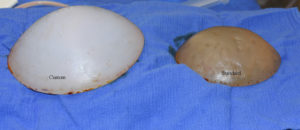While the most common form of buttock augmentation today is fat grafting (Brazilian Butt Lift surgery or BBL), buttock implants still have a role to play. They are the only other method of surgical buttock augmentation for those patients who do not have enough fat to harvest for a BBL or have failed previous BBL efforts due to fat absorption.
Like all aesthetic implants used in the body, buttock implants provide permanent volume in a single surgical effort. But the final outcome both in volume and shape is determined by that of the implant’s design. Buttock implants come in both round and anatomic designs and volumes up to 700ccs. While the pocket location can be either intramuscular or subfascial, larger buttock implants sizes have to be placed on top of the gluteus maximus muscle.
One of the design problems in larger buttock implants is that they often can result in a ‘bubble butt’ appearance. This is caused by the high projection compared to the base diameter of the implant. While breast implants are designed to look spherical, such an appearance for the buttocks is not as desired by most patients. To get a more natural look, custom buttock implants have a wider base diameter with less projection. The concept is that in the buttocks, the diameter of the implant is more important than its projection.

The base diameter of custom buttock implants mandates that they be placed in the subfascial position rather than in the intramuscular location. This also allows for a greater influence on the hip region that would otherwise be obtainable.
Dr. Barry Eppley
Indianapolis, Indiana


